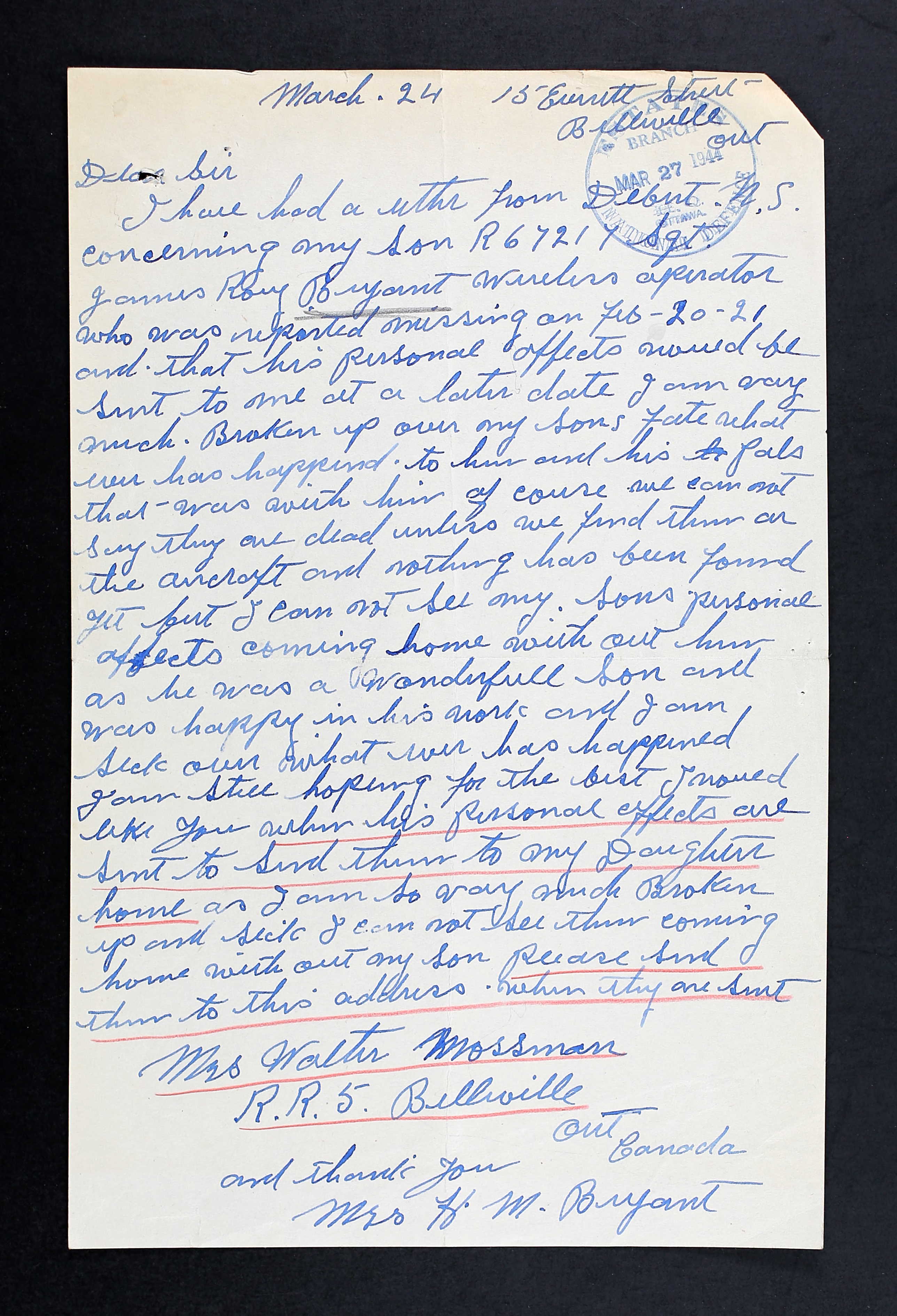
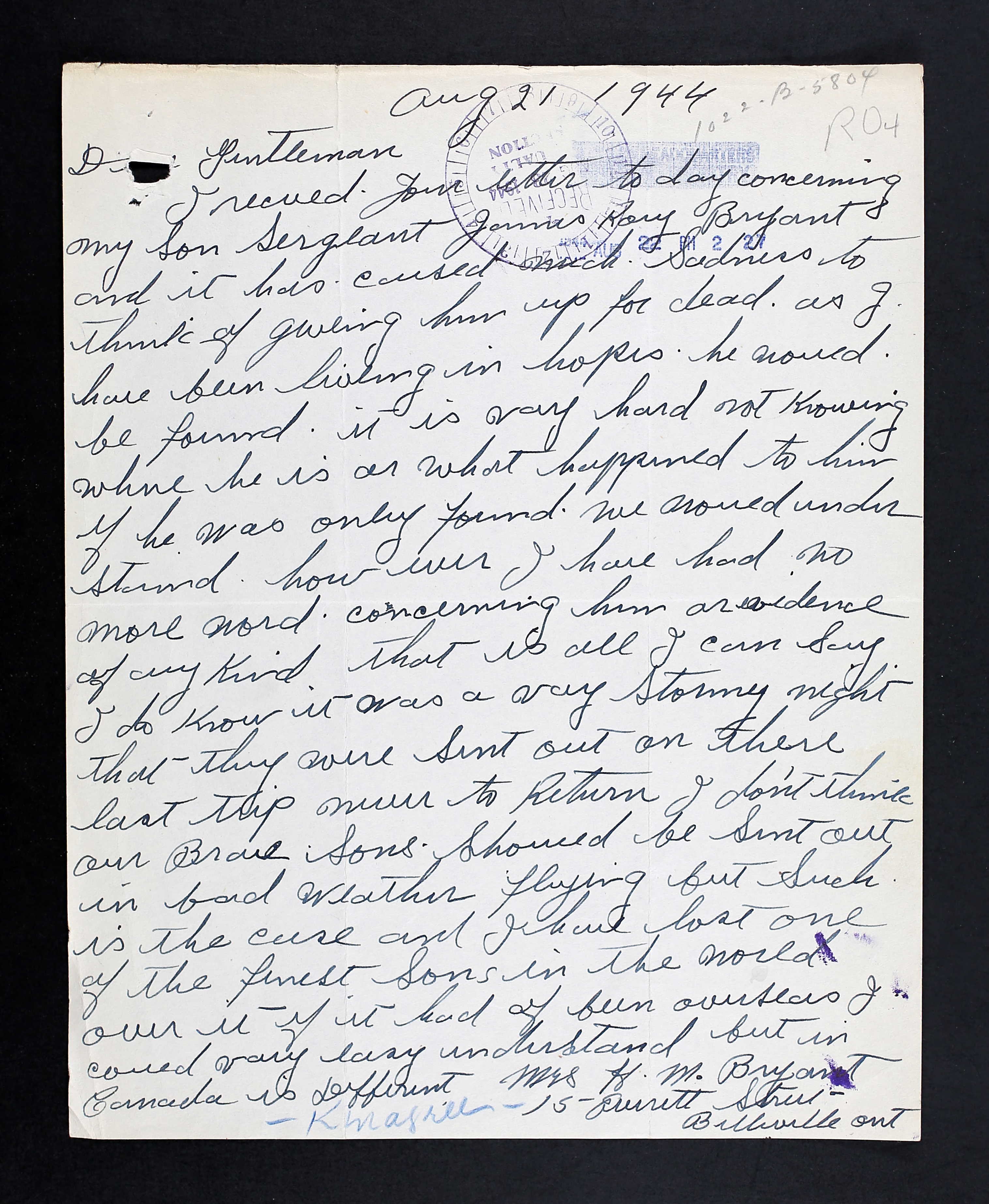

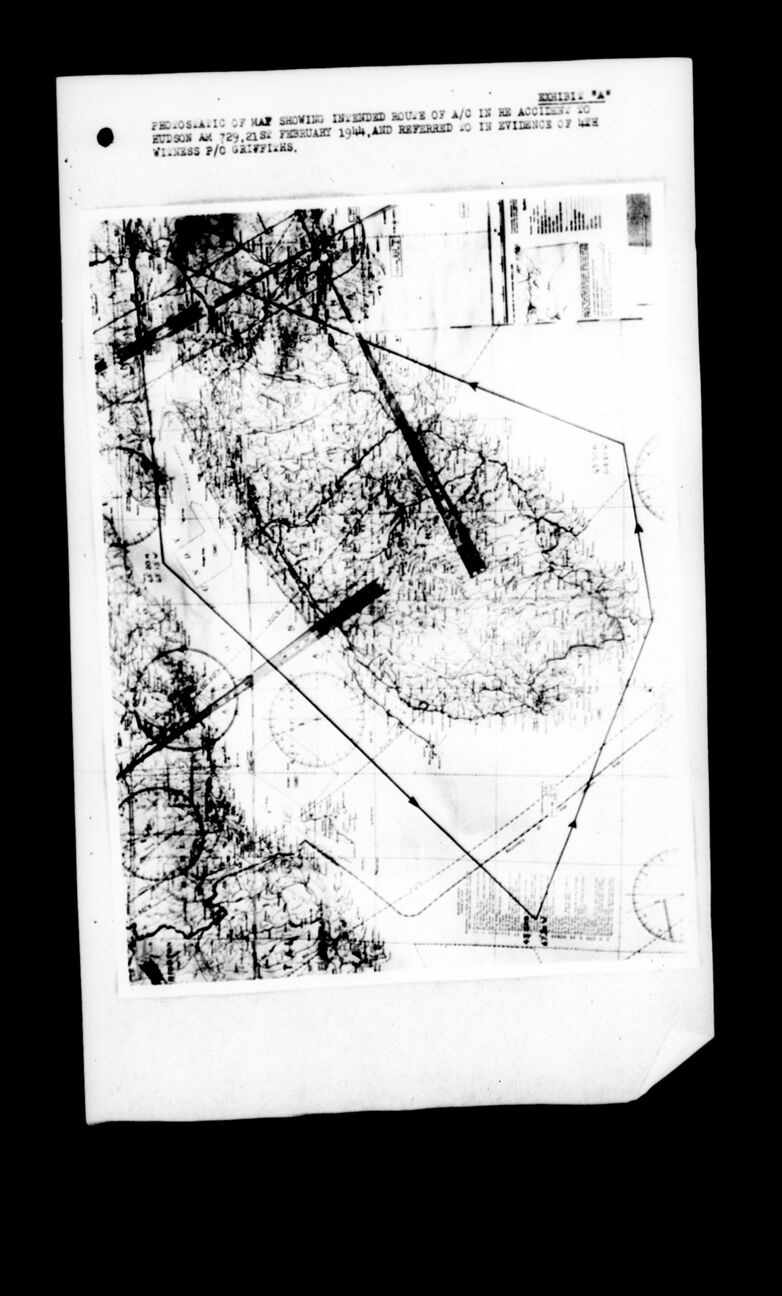
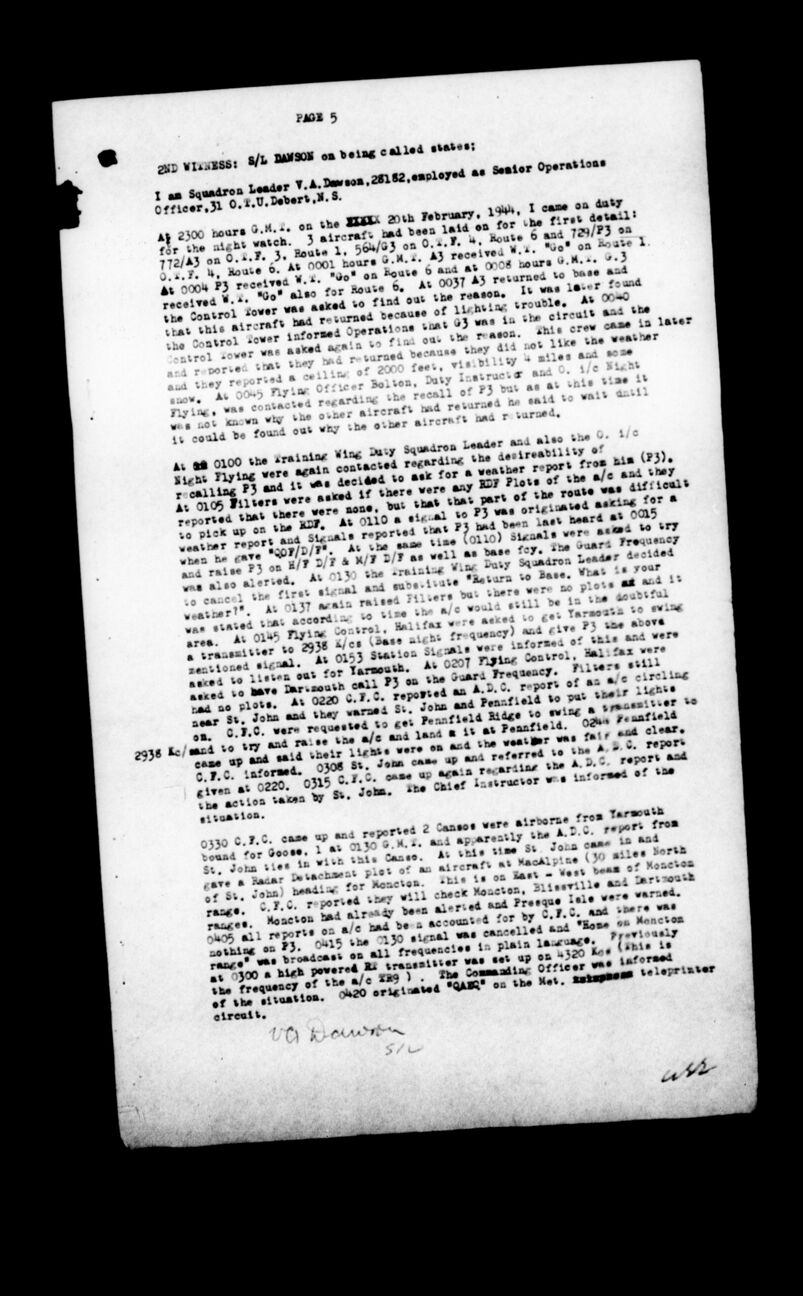
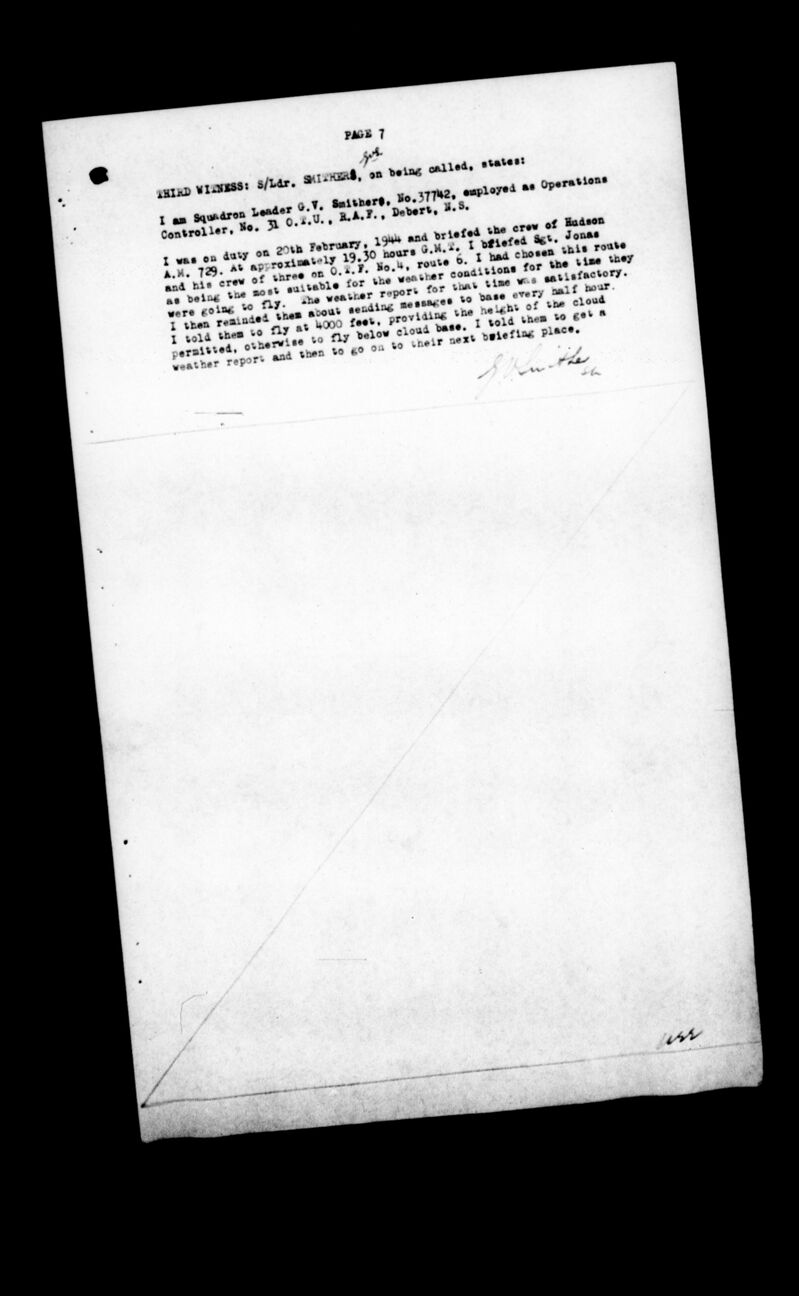
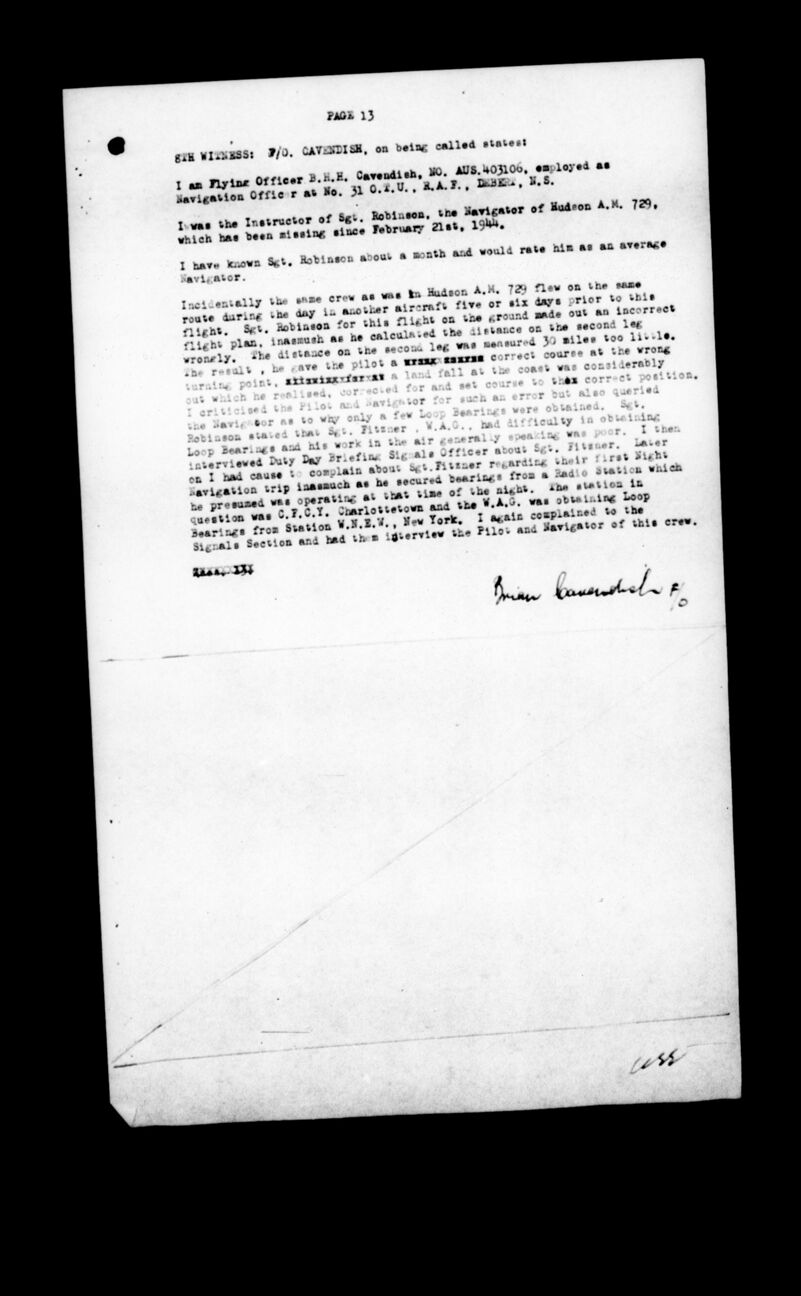
January 18, 1922 - February 21, 1944







James Roy Bryant was the son of Frank John Bryant (1868-1938), butcher, and Hattie May (nee Juby) Bryant (1886-1979) of Belleville, Ontario. He had two brothers, Frank K. Bryant, William ‘Bill’ Bryant (1924-2016) and two sisters Mary and Rosemarie. He had two half-brothers: George and Floyd Russell. A half-sister, Georgia, died in 1918. The family was Anglican.
Prior to enlistment in May 1940, he was a machinist for Alemite Company. He planned to return to his position after the war. He played the trumpet in a band, played hockey and baseball, plus liked to swim. He felt he was suited to be an airframe mechanic (metal).
Jim stood 5’11” tall and weighed 162 pounds, had hazel eyes and brown hair. “Athletic physique; average mentality. Poor muscle balance, otherwise very fit; has education sufficient for pilot or observer. Personable.”
Jim’s journey through the BCATP began in Brandon, Manitoba at No. 2 Manning Dept October 10, 1940 until he was sent to Calgary November 4th. In December, he was sent to TTS, St. Thomas until May 16, 1940. He was then sent to No. 12 SFTS, Brandon until June 23, 1942.
He was taken on strength at No. 135 (F) Squadron, Mossbank, Saskatchewan June 24, 1942.
It appears he remustered and was sent to No. 3 Wireless School August 30, 1942, then to No. 8 B&G School at Lethbridge March 20, 1943.
In May 1943, Jim was at No. 1 AOS, Edmonton, then sent to Eastern Air Command, Halifax, Nova Scotia. He was at the station hospital October 30 until November 6, 1943 while at 31 O.T.U., Debert, Nova Scotia. He sent his mother $20/month.
Aboard Hudson AM729, James and the crew, Navigator: Sgt. Donald Robinson (RAF), Pilot: Sgt. Geoffrey Alan Jonas (RAF), and WAG: R183177 Sgt. Carl Patrick Fitzner (RCAF) were lost as the result of a flying accident out of 31 O.T.U. Debert, Nova Scotia, on a night operational training flight. James was the wireless operator. The flight was to have lasted about three and a half hours’ duration. They were last heard of at 0015 hours, having taken off at 0004 hours on February 21, 1944. The pilot was instructed to return to base if he encountered snow. Winds were calm and snow was encountered over the Bay of Fundy and other areas several hours later.
Sixteen witnesses were called at the Court of Inquiry held February 25 to March 1, 1944 at Debert, NS. [The complete Court of Inquiry can be found on microfiche C5934, starting at image 5024.]
The first witness, P/O R. B. Slater, J18413, was advised the weather would be favourable over the course to be followed and for the duration of the flight. The second witness, S/L V. A. Dawson, 28182, stated that one of the three aircraft sent out that night returned because they did not like the weather. A second returned because of lighting issues. The third witness, S/L G. V. Smithers, 37742, stated that he briefed Sgt. Jonas and his crew of three “on O.T. F. No. 4, route 6. I had chosen this route as being the most suitable for the weather conditions for the time they were going to fly. The weather report for that time was satisfactory. I then reminded them about sending messages to base every half hour. I told them to fly at 4000 feet, providing the height of the cloud permitted, otherwise to fly below cloud base. I told them to get a weather report and then to go on to their next briefing place.” The next two witnesses stated that they gave briefs to the pilot and crew including the weather, when they were to report in and their route. The fifth witness, WO D. M Coates, R78103, stated that he knew Sgts. Bryant and Fitzner. “As far as Sgt. Bryant was concerned as a WAG in my estimation, he was very good. He was careful, neat and cool-headed. As far as Sgt. Fitzner, in my estimation, he was careless, did not use common sense in his wireless work and not interested in his job.” The sixth witness, F/O E. J. A. Patterson, 129563, stated that he “started Sgt. Jonas on his course of instruction at this unit. He was a very keen student and showed almost above average ability. He soon learnt the exercises given to him and seemed to have no difficulties. He was a very steady pilot, level-headed and careful. Sgt. Jonas was conversant with the intercom radio in Hudsons and knew the principles of the radio compass, as well as the de-icing system and fuel system.” The eighth witness, F/O B. H. H. Cavendish, AUS 403106, stated that he knew Sgt. Robinson for about a month and rated him as an average navigator. “Incidentally, the same crew as was in Hudson AM 729 flew on the same route during the day in another aircraft five or six days prior to this flight. Sgt. Robinson for this flight on the ground made out an incorrect flight plan, inasmuch as he calculated the distance on the second leg wrongly. The distance on the second leg was measured 30 miles too little. The result, he gave the pilot a correct course at the wrong turning point, a land fall at the coast was considerably out which he realized, corrected for and set course to that correct position. I criticized the pilot and navigator for such an error but also queried the navigator as to why only a few loop bearings were obtained. Sgt. Robinson stated that Sgt. Fitzner, WAG, had difficulty obtaining loop bearings and his work in the air generally speaking was poor. I then interviewed Duty Day Briefing Signals Officer about Sgt. Fitzner. Later on I had cause to complain about Sgt. Fitzner regarding their first night navigation trip inasmuch as he secured bearings from a radio station which he presumed was operating at that time of the night. The station in question was CFCY Charlottetown and the WAG was obtaining loop bearings from Station WNEW New York. I again complained to the Signals Section and had the interview the pilot and navigator of this crew.” Two more witnesses confirmed the four crew were in the Hudson aircraft at time of take-off, with the pilot, Sgt. Jonas standing behind him, observing the run up to be in good order.
“The route which the aircraft was to have followed was from Debert down the centre of the Bay of Fundy until approximately opposite the southern tip of Nova Scotia, thence to the southern tip of Nova Scotia, following along the south shore as far as St. Margaret’s Bay, where it would set course for base. Ground RDF stations, in both Canada and the United States, invariably pick up the aircraft on this exercise when at the southern and southwestern limits of its patrol. In this particular case, no plots were obtained, and it is, therefore, assumed that the mishap occurred shortly after take-off. An extensive search was conducted...Searches continued on the northern part of the Bay of Fundy as well as the west coast of the Bay of Fundy.”
REMARKS OF INVESTIGATING OFFICER: “A signal was received from the aircraft twelve minutes after take-off to the effect it was going over to D/. Neither the aircraft or its crew have been heard of since that time. The crew were properly briefed as to navigation, signals, and the weather. The aircraft was fully serviceable prior to take off. RECOMMENDATIONS: this investigating officer has done a number of missing an last aircraft investigations. In the majority of cases, the crews were students. There is one thing that characterizes nearly all of these cases. It is the paucity of radio and wireless messages received from the aircraft. The cause of this situation cannot be blamed on any one thing in as much as the facts obtainable from the cases were limited. Now is the investigator so sure that the situation can be improved on under the present setup. However he does not wish to draw the attention of the training branch to the abovementioned fact established by these cases, and to suggest that possibly more information could be obtained from students in distress if more emphasis were placed, during their training, on the importance and necessity of sending messages when their aircraft is in difficulty. It should be hammered into them that messages must be sent frequently and continuously until out of trouble, that a message of any kind to any place is better than nothing, that this is the only way aid can be given, and what is more important prevention of similar accidents is greatly handicapped when the crews tell nothing. The investigator inquired into the point at this unit and it appears the staff has conscientiously endeavouring to sink into the minds of the students the importance of sending messages when in difficulties.” He noted what F/O H. A. Munro, J21066, student WAG, the fourteen witness said. “Certainly in our training here this matter is impressed on us fully. At every briefing we are instructed to get OK messages through to base every half hour using all available unit frequencies. If at the end of one hour we have not contacted our unit instruction is given to change the guard frequency. In the interests of safety, I might suggest the establishment of M/F D/ F, one on Cape Breton island, one in Yarmouth area, working in conjunction at this unit that a triangular fixed may be obtained on aircraft in difficulty. With regard to this unit's night M/F control, it is badly jammed by Malton Ontario…and by R/T Station in Mexico. An increase in output of Debert’s 2938 Kcs might overcome this difficulty.”
March 21, 1944: “Investigation into recent aircraft accidents have shown that crews of aircraft are not making full use of the R/T facilities available as aids to navigation or as means of communicating their trouble(s) to their base or other station. It is essential that all Pilots, Navigators, and WOAGs are conversant with the radio aide at their disposal and the procedure to be carried out in conditions of emergency. These points must be stressed during lectures and at every pre-flight briefing. When two-way communication between aircraft and ground station cannot be maintained, the captain must be instructed to proceed to and land at the nearest suitable airfield...and remain there until the aircraft radio equipment has been repaired or if this is not possible, until authority is given to proceed to base with unserviceable radio equipment.”
Mrs. Bryant wrote a letter dated March 24, 1944: “I am very much broken up over my son’s fate whatever has happened to him and his pals that was [sic] with him of course and cannot say they are dead unless we find them or the aircraft and nothing has been found yet, but I cannot see my my son’s personal effects coming home without him as he was such a wonderful son and was happy in his work and I am sick over whatever has happened. I am still hoping for the best…send my son’s personal effects to my daughter’s home as I am so very much broken up and sick. I cannot see them coming home without my son.”
A letter dated August 21, 1944, written by Mrs. Bryant: “I received your letter today concerning my son…and it has caused much sadness to think of giving him up for dead as I have been living in hopes he could be found. It is very hard not knowing where he is or what happened to him if he was only found. We would understand however I have had no more word concerning him or evidence of any kind that is all I can say. I do know it was a very stormy night that they were sent out on their last trip never to return. I don’t think our brave sons should be sent out in bad weather flying, but such is the cure and I have lost one of the finest sons in the world over it. If it had been overseas, I could very easy understand, but in Canada, it is different.”
When Mrs. Bryant filled out the estates form in October 1944, she wrote, “My son, James, had a bond and I am not sure if he was still paying for it or not, but he did say it was for me if anything did happen to him, but I don’t know where it is. Will you please find out? He might of [sic] had a will made in the air force but none at home.”
In the spring of 1945, Mrs. Bryant wrote, “I assure you it is a terrible worry not knowing what happened to my son and the crew. I only hope something will turn up some day that will end this dreadful anxiety.”
June 17, 1945, Mrs. Bryant wrote, “I am the mother and his dependent…he is my only single son and he sent me money all the time he was in the service as I am a widow and have been for 8 years. I still have three sons in the service besides Jim, but there were all married before going into the service 5 years ago. I was the sole beneficiary of my son’s will and I was his dependent as he was my only single son. If there is anything more you would like to know, I will be pleased…I have been expecting this gratuity money. I also now you gentleman would look after it for me. I also have a daughter 14 years and the money will sure be a great help in keeping her in school. I am assure you it has caused great grief not knowing where my son is or not know just what happened to him and crew. Thanking you for taking care of things for me.”
In August 1947, Mrs, Bryant received Jim’s logbook.
In late October 1955, Mrs. Bryant received a letter informing her that since Jim had no known grave, his name would appear on the Ottawa Memorial.